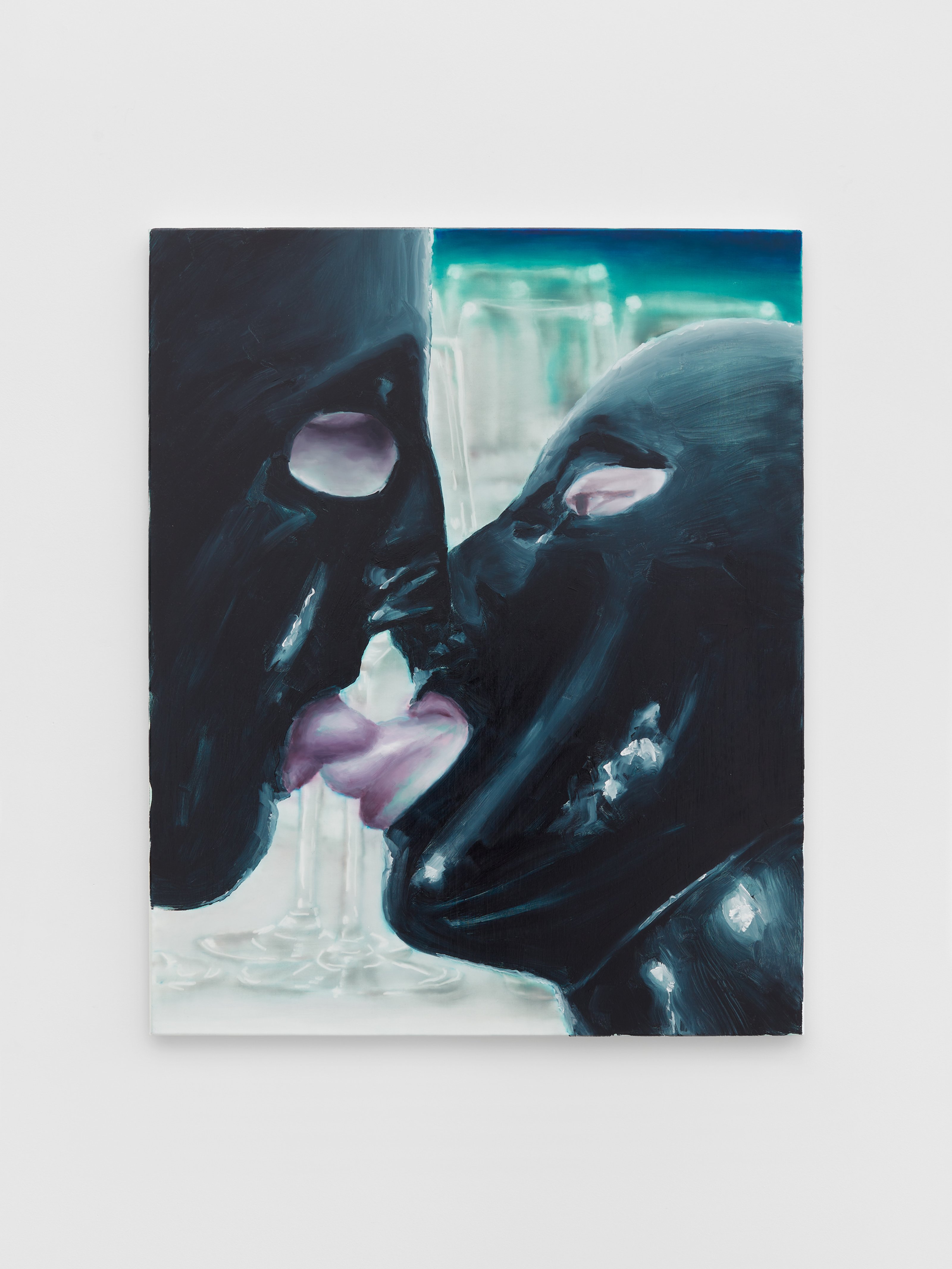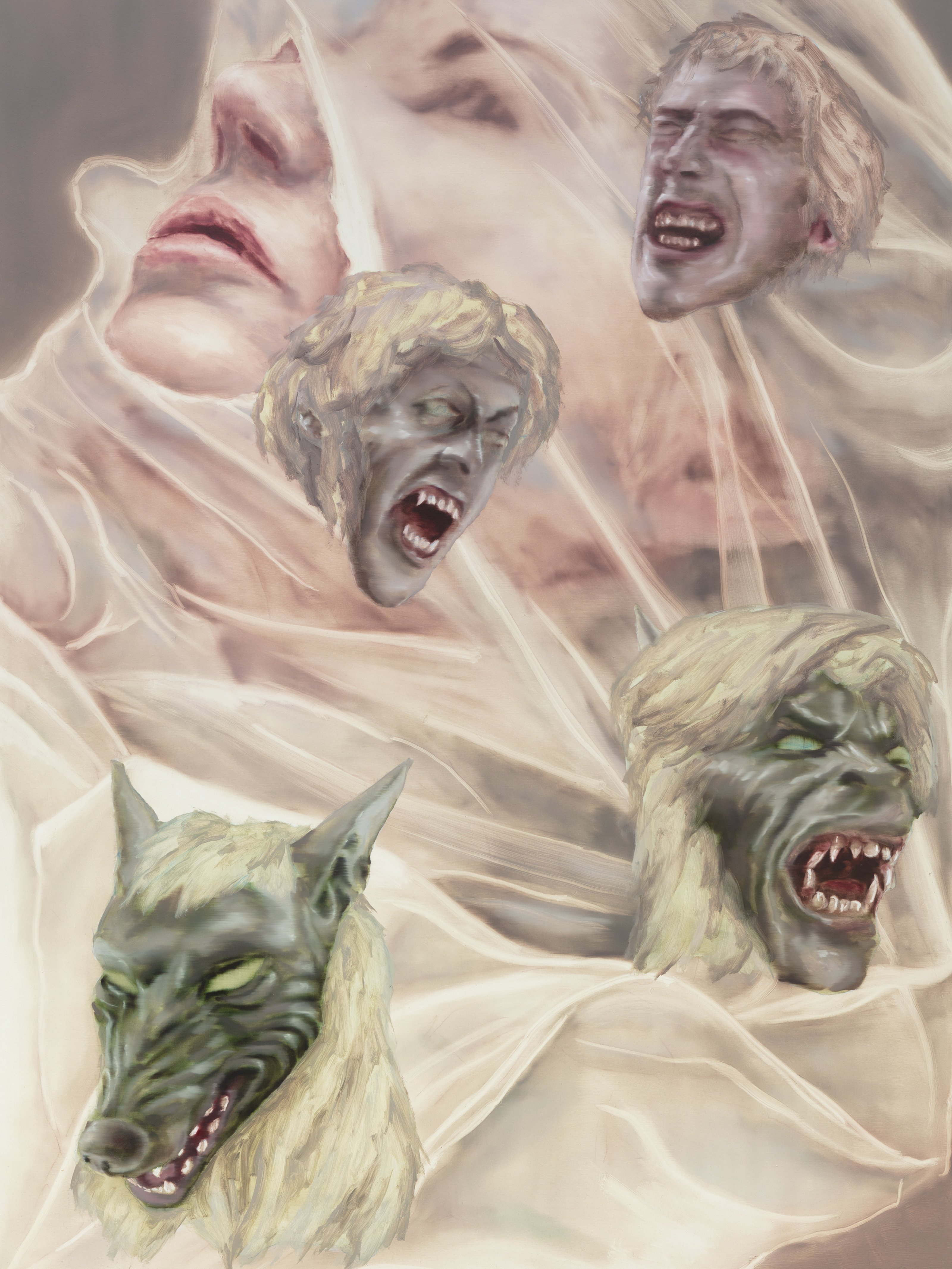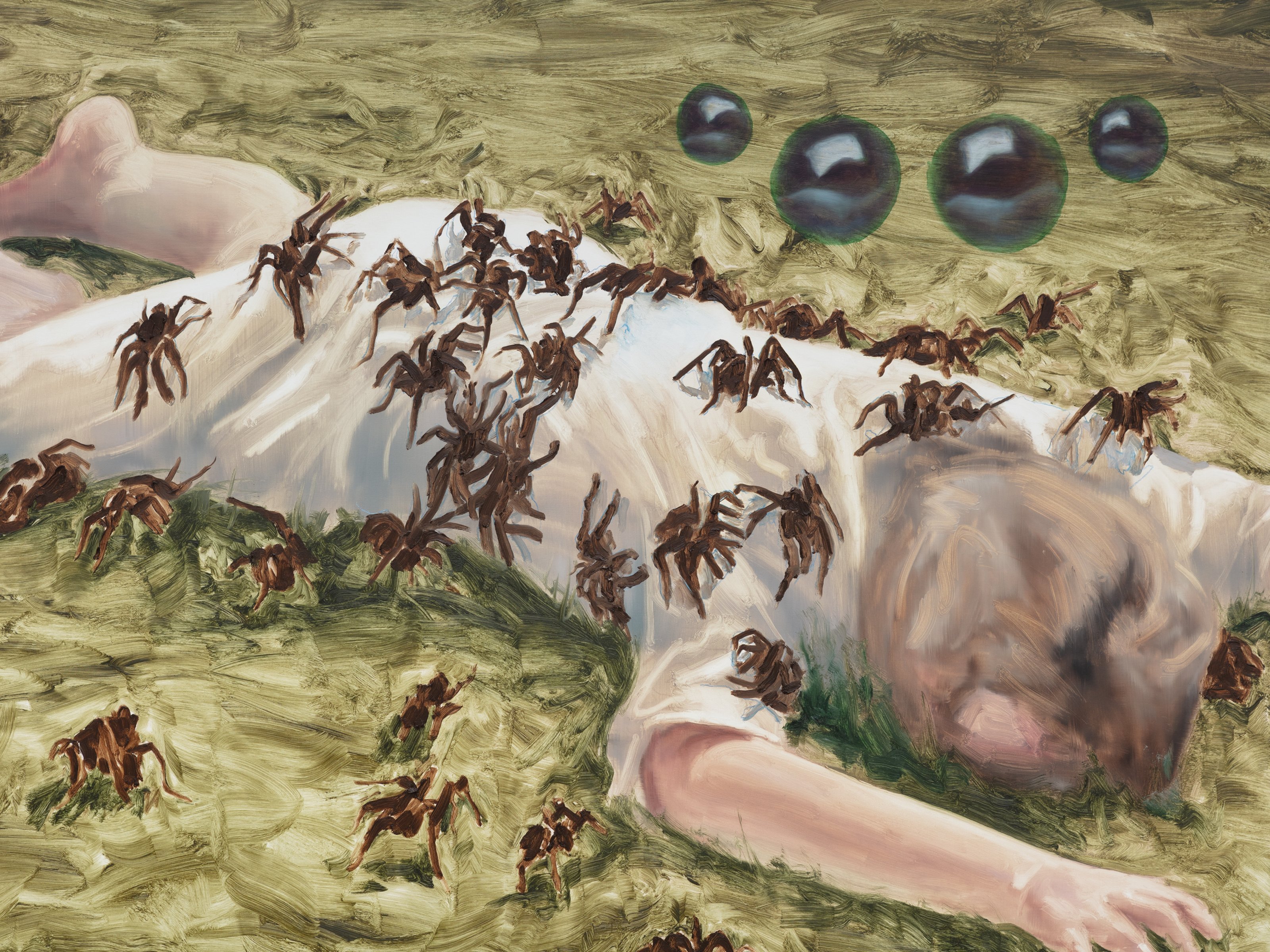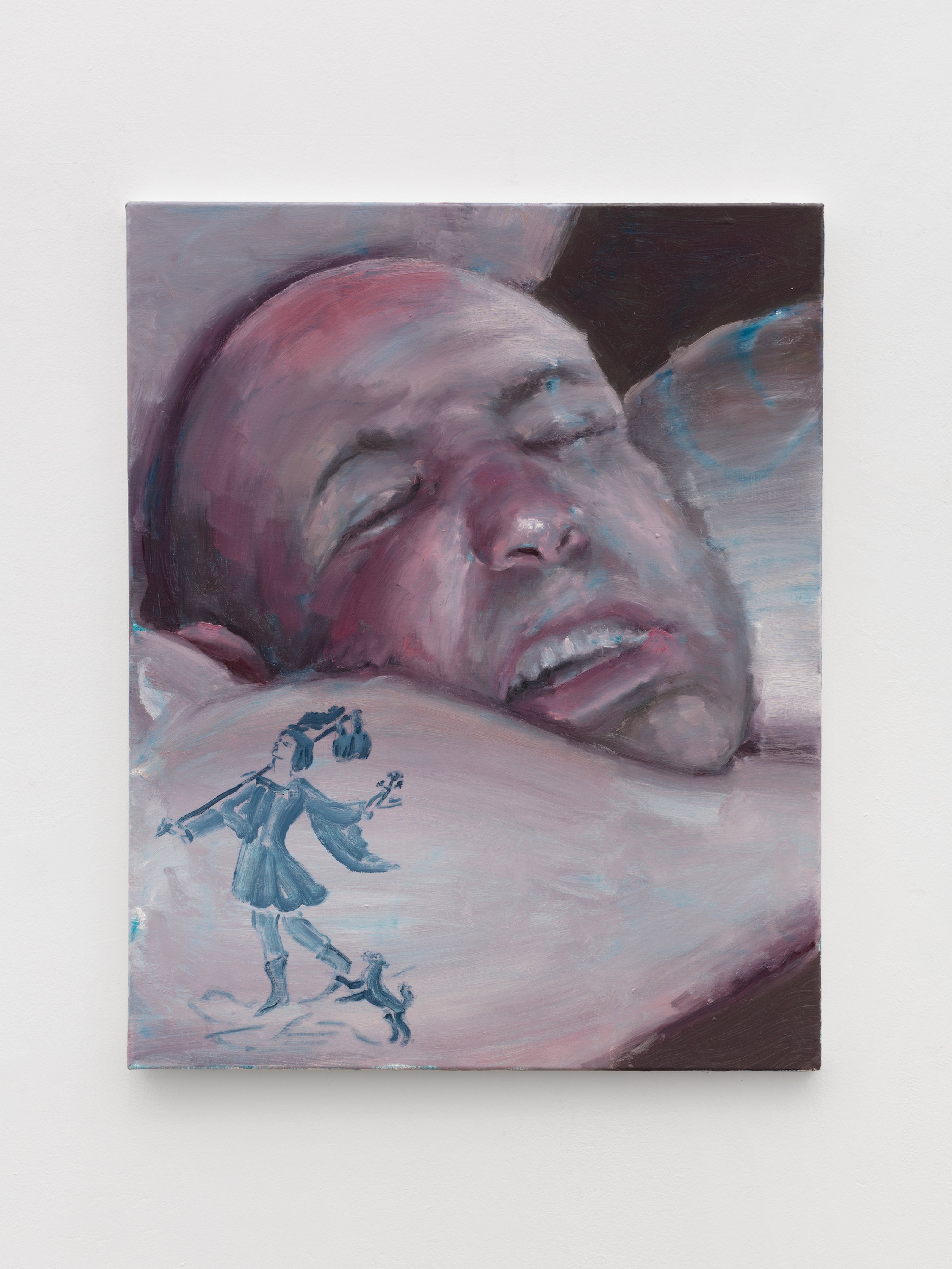Installation views
Running through a peculiar late winter period (February 17th – April 1st) in Britain when nothing works and underpaid transport workers, nurses, teachers, university staff, junior doctors, and others were on strike, painter Tomas Harker gives us “Multiple Choice Fairytale Ending” (all works 2022) at The Sunday Painter, London. Upstairs we get dreamlike surrealism with strange but not always unpleasant images of fairies in wine glasses, lobsters awaiting execution, and dogs. Downstairs, despite the crisp light streaming into the space from South Lambeth Road above, there are terrible frights on display: growling werewolves, cascading spiders, impish demons.

There are at least two ways of reading Harker’s images. The first has to do with identifying the artist’s style. This would place it in a general trend alongside other artists who work with similar themes. Indeed, the identifiably weird look and eerie feel of Harker’s works resonate with the work of many of his contemporaries. This style, if it is one, could be described variously as: “naïve surrealism” (see the two disembodied hands holding what looks like a miniature model of an American suburban home in Heimlich), “dark romanticism” (two figures in latex gimp masks kiss in 1st Person Indulgence), or “new uncanny figuration”, of which each painting here could be an example. There’s no way of knowing whether these names will stick, but they certainly pick out something.

Harker is hardly alone in showing us how everyday things are haunted by terrible imaginings. But there is one area in which he is highly original: not just his unique choices of what to depict, but the influences of those choices. Horror movies seem to play a role, as in the snarling werewolf with a shaggy blonde mane of hair in Shapeshifter, or the physically traumatising human-to-werewolf transformation process that takes place in Simulacra of the Self.
Some of these images, however, owe much to classic surrealism, fusing things that don’t belong together in one pictorial space. In Heimlich or Simulacra of the Self a werewolf transformation seems to take place in a fantasy world. Here, we see the change happen in four successive stages from the point of view of the agonising metamorphosis of a male human skull and facial features, which is shown on and around a dreamy-eyed woman, whose own head and face take up most of the picture plane, partially concealed by a translucent, veil-like material.
Shapeshifter, 2022.
Shapeshifter, 2022. Detail
Simulacra of the Self, 2022.
Heimlich, 2022
Fairytale Ending, 2022
Installation view.
Highway Hypnosis, 2022
Installation view.
There’s also an unmistakably local sensibility in Harker’s work influenced by observations of British life. There are two very clear examples in “Multiple Choice Fairytale Ending”. One is the ruined white van with the green fairy logo marooned in the woods in Fairytale Ending. The other is the two panels of Highway Hypnosis, in which typical green British motorway signage points towards a place called “Inferno” alongside woodland haunted by a wretched demon. The creature is barely visible at first, submerged in the murk of the trees at night, which only makes it more unnerving when the viewer eventually notices it, swooping towards us from the wooded gloom.
Though Harker’s ideas and painterly choices are certainly his own, his work, again, fits neatly into a certain tone and tendency seemingly exhibited by a number of millennial artists working today. They tend to have similar ideas and use similar techniques to express similar terrors, and they all refer to the mood of the present with varying degrees of violence and subtlety. This is what makes Harker’s work ripe for a second interpretation – one that looks at the details lying just beneath the surface of the general mood of darkness and lurking terror.

This second approach is about interpreting the works’ latent social and political content which, at times, may seem so indirect that some viewers might not initially think it’s there at all. Sigmund Freud’s concept of “overdetermination” clarifies these forms. In the psychoanalyst’s understanding of dreams, overdetermination refers to how one thing (a dream or symptom) is produced by multiple interacting and overlapping causes. This can help us to rearrange the layers of meaning in Harker’s images. The political content, meanwhile, derives from the influence of Freud’s theory of dreams on Louis Althusser’s understanding of political revolution, which is also described in terms of overdetermination.
This applies to whatever Harker paints, whether it’s actual images of horror and trauma (Shapeshifter, Simulacra of the Self, Fairytale Ending, the masses of hideous spiders crawling over a prostate human body in Necrophilia Immersion Therapy), or at least superficially more benign images, like the fairies dancing in wine glasses in Initiation, the lobsters apparently awaiting their searing fate in Last Supper on the Titanic, or the overlapping and indistinct presence of several dalmatian dogs in I’ll be your Mirror.
Necrophobia Emersion Therapy, 2022
Last Supper on the Titanic, 2022
Last Supper on the Titanic, 2022. Detail.
I’ll be your Mirror, 2022
I’ll be your Mirror, 2022. Detail.

Each image is troubling in its own way, but they’re all similar in tone. And they’re all equally inconclusive. There’s a rich implied terror hiding just behind all the seemingly less threatening images, but the works that use straightforwardly horrifying imagery suggest something more emotionally erratic. In both cases, we can only make sense of these pictures and the feelings of unease they evoke by piecing together certain complex chains of associations and allusions, whether or not we can or even want to reconstruct anything specific about Harker’s own imagination or the state of his unconscious fantasies. However, the images’ apparent lack of direct political content presents us with a challenge. It’s hard not to see, in these intersecting traumas, references to what makes early twenty-first century life so uniquely anxiety provoking. These worries are surely caused by the relationship between the social and economic conditions under which we live and the prevailing political climate as much as they do the artist or any viewer’s unique personal troubles.
Freud writes that dreams and neurotic symptoms are “overdetermined”. They’re formed from unconscious material produced by several different events at different times and different places in a person’s life. All of these can be understood on their own terms without any one of them being the deciding factor when they eventually appear. In dreams, for example, the unconscious content is “represented in the dream-thoughts many times over”1 through condensation (when several dream-thoughts converge and relate to one another) and displacement (where apparently less emotionally significant dream-thoughts appear more clearly in the content of a dream). In Harker, each image, whether apparently nonthreatening like the dalmatians or openly terrifying like the spiders, represents multiple things simultaneously without any one of them determining its overall meaning. Louis Althusser, meanwhile, adapted Freud’s idea and applied it to revolutionary politics, arguing many different “radically heterogeneous”2 factors, including a nation’s history, politics, traditions, religion, and social mores, are responsible for revolutionary change, and not simply the “general contradiction” between capital and labour, the working class and the bourgeoisie, expressed through economic activity or technology.
Initiation, 2022
Fairytale Ending, 2022. Detail.
Overdetermination, at both a dream-imagery and political level, appears throughout “Multiple Choice Fairytale Ending.” For instance, Fairytale Ending, Initiation, and Highway Hypnosis all condense several horrors into basic units of imagery (dancing fairies, motor vehicles) and settings (anonymous British roads, perhaps a drinks reception or dinner party). They also share dark fantasies (fairies, demons lurking in the mysterious and threatening woods), representing certain fears that could come to any one of us at any moment in early 21st century Britain.
It’s significant that the crashed vehicle in Fairytale Ending is a white van. Perhaps the driver fits a classic British stereotype of the “white van man.” This stock character is typically an independent, self-employed tradesperson like a builder, plumber, or locksmith who uses this kind of vehicle to get between jobs. They are represented as being selfish and inconsiderate road users, often aggressive in their interaction with other drivers and other members of the public (the suggestion of sexism and perhaps racism is never far away). Their socially mobile class position isn’t, however, so easily legible outside of Britain’s deeply embedded and still-strict social codes. For those reading these images fringed with American class assumptions, or those of many other nationalities, it might not be expected that this individual’s potentially chauvinistic, nationalistic, and sharply individualistic political beliefs may well align with the Conservative Party (though maybe they voted for New Labour’s Tony Blair in 1997 if they’re old enough) and what they read in the columns of tabloid newspapers like The Sun, The Daily Express, or most likely The Daily Mail. This is just one product of the many subtleties of Harker’s visual imagination.
Sense of Security, 2022
Sense of Security, 2022. Detail.
Installation view.
Perhaps the driver in Fairytale Ending was careless. Maybe they were spooked by the demon emerging rancorous from the woods. It is left up to the viewer to decide whether the trees and (unseen) road in this painting are the same as those in Highway Hypnosis, as if the driver was on his way to Inferno to do a job, to meet someone (a friend, a colleague, a mistress) or even to drink the wine that is being served in Initiation. It is also mysteriously left open that the logo on the van in Fairytale Ending – marking an unexpected contrast with the implied and thoroughly socially-constructed masculinity of the driver, but perhaps suggesting the sprightliness of the service – is the same prancing green fairy that we see cavorting in the wine glasses in Initiation. Though Fairytale Ending gives an obvious image of change (a car-crash as a pure image of causality), it is condensed with the images of transformation in Shapeshifter, Simulacra of the Self and the merely implied change in Last Supper on the Titanic, in which the two huge lobsters await their fate, as we all must.
The dark prevailing mood of the work of Harker connects to what Michael Hardt and Antonio Negri call the “omni-crisis”. This does not refer to the gargantuan crisis that defines modern life, the conflict between the transformative potential of revolutionary energies and those authoritarian social and political forces that try to stifle them. The omni-crisis is, rather, the “proliferation of minor and indefinite crises”3 in a globalised society, where power is diffuse and war is constant, which cannot be pinned down in any one place or sector of society because they are everywhere and all the time and can pop up at any moment. In the works of Tomas Harker, the omni-crisis is expressed not just in car-crashes, demons, spiders, and werewolves, but even in lobsters, dogs, and wine glasses.
“Multiple Choice Fairytale Ending” shows us one of the directions figurative painting is taking in these troubled times, but also manages to serve as a timely register of a range of traumas none of us ever expected to share. Some of his images are locally specific, creating the risk that they won’t be legible outside a British context. The moment they are unpacked, however, a relatable discomforting feeling expressed through plentiful minor crises cascade from the images, crawling all over us, like terrible spiders.